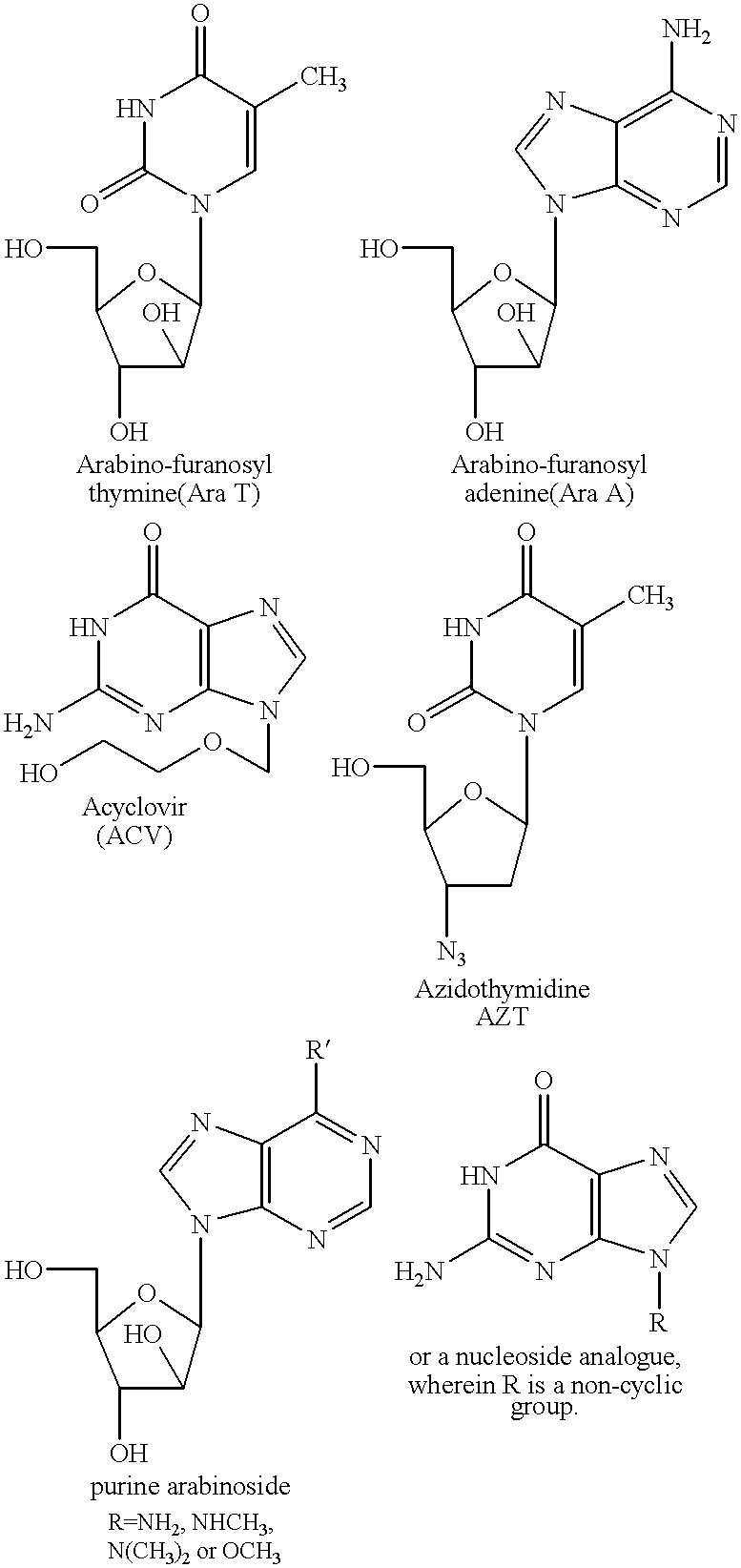Fatty acid esters of nucleoside analogs
a nucleoside analog and ester technology, applied in the field of fatty acid esters of nucleoside analogs, can solve the problems of no immunity, pain in herpes infection, patient may become very ill, etc., and achieve the effect of strengthening the inhibitory effect of compounds according to this invention
- Summary
- Abstract
- Description
- Claims
- Application Information
AI Technical Summary
Benefits of technology
Problems solved by technology
Method used
Image
Examples
example 2
5'-O-(cis-9"-Hexadecenoyl)-1-.beta.-Arabinofuranosyl-Thymine
To a solution of cis-9-Hexadecenoic acid (4.0 g, 15.72.times.10.sup.-3 mol) in 40 ml anhydrous benzene was added oxalylchloride (1.5 ml, 17.72.times.10.sup.-3 mol) and the mixture was stirred under nitrogen at 35.degree. C. for 3 hours. The solvent and exess reagent was removed at high vacuum, and the residue was dilluted with 10 ml dichloromethane to prepare a stock solution of cis-9-Hexadecenoylchloride. To a solution of ARA-T (1.0 g, 3.87.times.10.sup.-3 mol) in 20 ml anhydrous pyridine and 10 ml N,N-dimethylformamide was added 2 ml of the stock solution and the reaction mixture was stirred under nitrogen at room temperature. A further volume of 4 ml stock solution was added in 1 ml portions at approx 8 hours intervals. After a total of 60 hours reaction time, the solvents were removed at high vacuum and the residue was dilluted with 50 ml water and 50 ml chloroform. Centrifugation of the resulting emulsion afforded a se...
example 3
5'-O-(cis-6"-Octadecenoyl)-1-.beta.-D-Arabinofuranosyl-Thymine
To a solution of ARA-T (1.0 g, 3.87.times.10.sup.-3 mol) in 20 ml anhydrous pyridine and 10 ml N,N-dimethylformamide was added 2 ml of a stock solution of cis-6-Octadecenoylchloride (2.1 g, 6.98.times.10.sup.-3 mol) in 6 ml dichloromethane, and the reaction mixture was stirred under nitrogen at room temperature. The remaining stock solution was added in 2 ml portions at approx. 12 hours intervals. After a total of 60 hours reaction time, the solvents were evaporated at high vacuum and the residue was dilluted with 65 ml chloroform and 65 ml water. The resulting emulsion was centrifugated and the organic phase was treated with brine, concentrated and the residue was recrystallized to give 1.1 g (55%) of the title compound as a white solid.
.sup.1 H NMR (DMSO-d.sub.6, 300 MHz).delta.: 11.28(1H,s,N--H), 7.35(1H,s,H-6), 6.05(1H,d,H-1'), 5.65(1H,d,OH-2'), 5.55(1H,d,OH-3'), 5.28(2H,m,CH.dbd.CH), 4.45(1H,m,H-5'.sub.1), 4.15(1H,m,...
example 4
5'-O-(cis-9"-Octadecenoyl )-1-.beta.-D-Arabinofuranosyl-Thymine
To a solution of ARA-T (1.0 g, 3.87.times.10.sup.-3 mol) in 20 ml anhydrous pyridine and 10 ml N,N-dimethylformamide was added 2 ml of a stock solution of cis-9-Octadecenoylchloride (2.1 g, 6.98.times.10.sup.-3 mol) in 6 ml dichloromethane, and the reaction mixture was stirred under nitrogen at room temperature. The remaining stock solution was added in 2 ml portions at approx. 12 hours intervals. After a total of 60 hours reaction time, the solvents were evaporated at high vacuum and the residue was dilluted with 65 ml chloroform and 65 ml water. The resulting emulsion was centrifugated and the organic phase was treated with brine, concentrated and the residue was recrystallized to give 1.2 g (60%) of the title compound as a white solid.
.sup.1 H NMR (DMSO-d.sub.6, 300 MHz).delta.: 11.28(1H,s,N--H), 7.35(1H,s,H-6), 6.05(1H,d,H-1'), 5.65(1H,d,OH-2'), 5.55(1H,d,OH-3'), 5.28(2H,m,CH.dbd.CH), 4.45(1H,m,H-5'.sub.1), 4.15(1H,m...
PUM
| Property | Measurement | Unit |
|---|---|---|
| weight | aaaaa | aaaaa |
| temperature | aaaaa | aaaaa |
| temperature | aaaaa | aaaaa |
Abstract
Description
Claims
Application Information
 Login to View More
Login to View More - R&D
- Intellectual Property
- Life Sciences
- Materials
- Tech Scout
- Unparalleled Data Quality
- Higher Quality Content
- 60% Fewer Hallucinations
Browse by: Latest US Patents, China's latest patents, Technical Efficacy Thesaurus, Application Domain, Technology Topic, Popular Technical Reports.
© 2025 PatSnap. All rights reserved.Legal|Privacy policy|Modern Slavery Act Transparency Statement|Sitemap|About US| Contact US: help@patsnap.com



